Average sizes and life expectancy for this breed:
Norwegian Forest cats are large, affectionate cats lovingly nicknamed "Wegies" by fans and cat lovers. Wegies are famous worldwide and especially adored in their native land of Norway, where these cats go by the name skogkatt. Norwegian forest cats are thought to be the cats of the Vikings. Their history can be outlined back to Norse lore.
At first glance, the Norwegian Forest Cat may look like other semi-long haired or longhaired cat breeds such as the Maine Coon. However, there is a significant difference between the Wegies and other longhaired cats.
They are large cats with almond-shaped eyes on their symmetrical triangle-shaped head. If they are viewed from their side, the Norwegian Forest Cat has a straight profile, boasting straight from their brow ridge to the tip of their nose. They have heavily furnished ears that fit into the triangle finish appearance.
These cats can make excellent feline companions and are amazingly gentle and calm, considering their huge size. Norwegian Forest cats are loving, laidback and undemanding feline companions. If you can give lots of love and attention to your Norwegian Forest cat, they will make a wonderful family pet.
Despite their huge size, the Norwegian Forest cat is a very calm and affectionate breed with a strong instinct. Their luxurious and lush coat makes them look bigger than they are, and it also served as natural protection when they used to live in the forest.
Remarkably devoted, they love to follow their human companion around the house and hang out with them. Norwegian Forest Cats are not too loud or vocal but tend to "talk" in meows and chirps.
This cat breed is both affectionate and an independent member of the family who loves attention but does not demand it.
Expect your Norwegian Forest cat to share an affectionate purr and press its head against your hand. However, if you are looking for a "lap cat", this majestic cat might not be the best choice. This breed prefers to stay close to their human companion, such as on the back of the couch. It's not that the friendly cat won't sit with you, but as a smart, independent cat, they are the ones who decide for how long and how close. Notably, it is common for a Norwegian Forest Cat to select their favourite person in their home.
See available kittens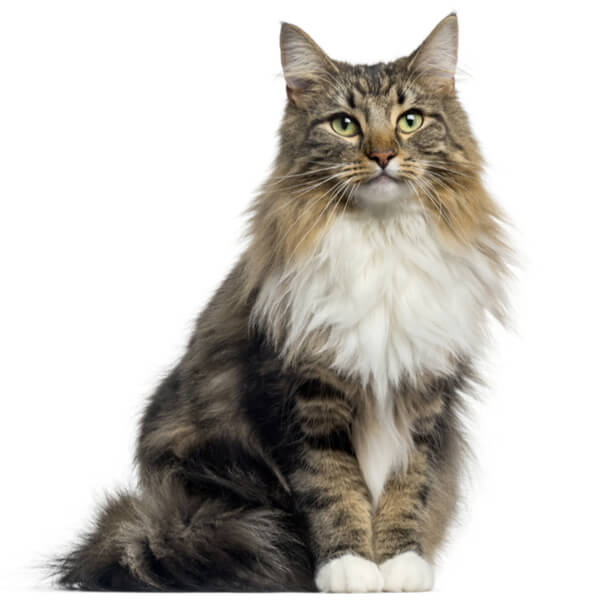

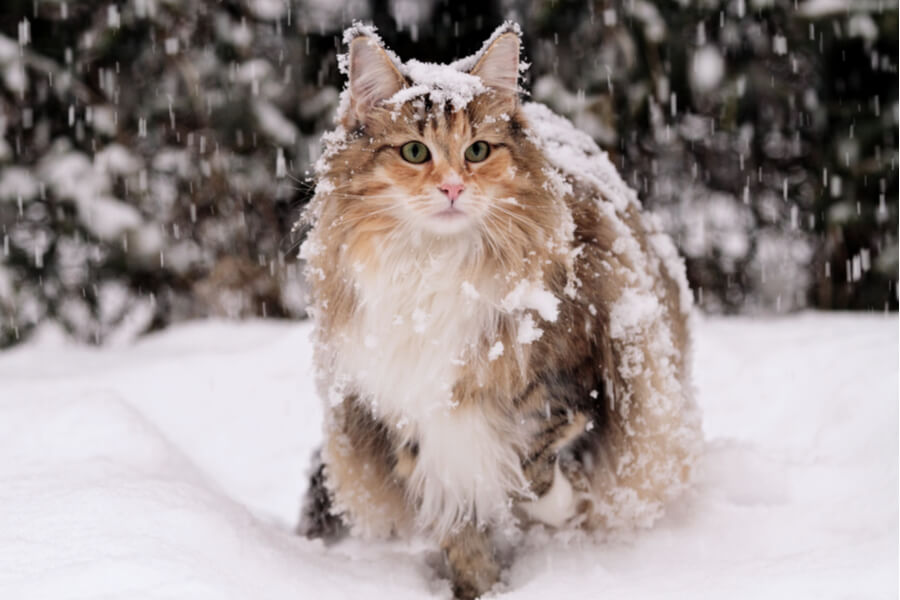


There is a Norse folktale about a cat that paves its way in and out of the trees in the forest, appearing and disappearing like magic. Occasionally, all that can be seen is their long, dense furry tail. This magical cat knows what is happening while humans do not. She can even identify what is in the heart of a man. This beautiful and majestic cat with its lovely, unusual tail is the Norwegian Forest Cat.
Aside from the lovely legend of this cat breed, it is most likely that the ancestors of the Norwegian Forest cat served as ships' cats (mousers) on Viking ships. In the 19th-century, cat breeders in Norway started to develop their magical forest cat into a breed that would be recognized for the show bench.
It took some time for the Norwegian Forest Cat to pave its way to the United States, where the Maine Coon, its native forest cat, already held the country spellbound. With a group of cat breeders dedicated to keeping and maintaining the Norwegian Forest Cat in the show hall, this cat breed became well-known in the United States, where it now has a dedicated following.
In 1984, The International Cat Association was the first North American registry to grant Championship status to the Norwegian Forest Cat. The Cat Fanciers Association then accepted the breed for full championship status in 1993.
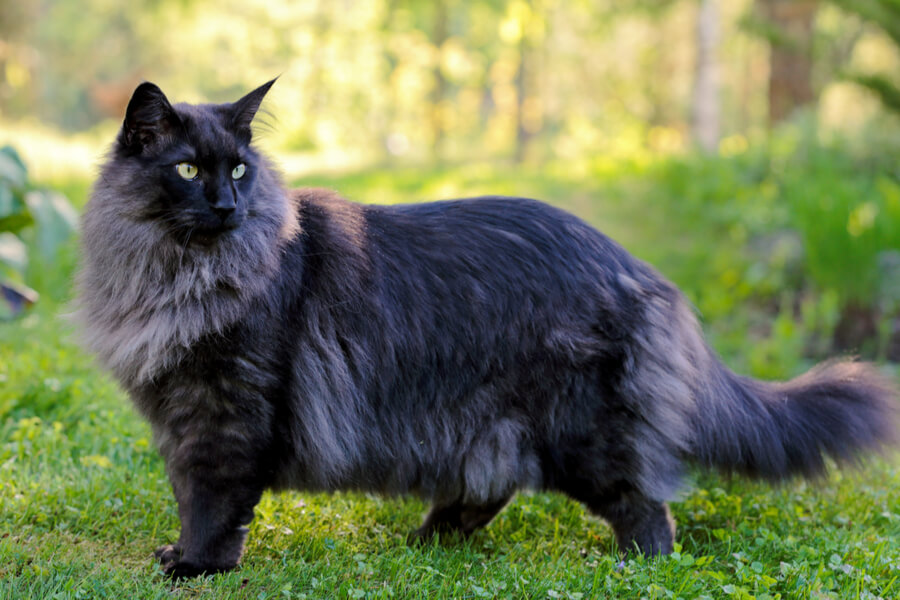
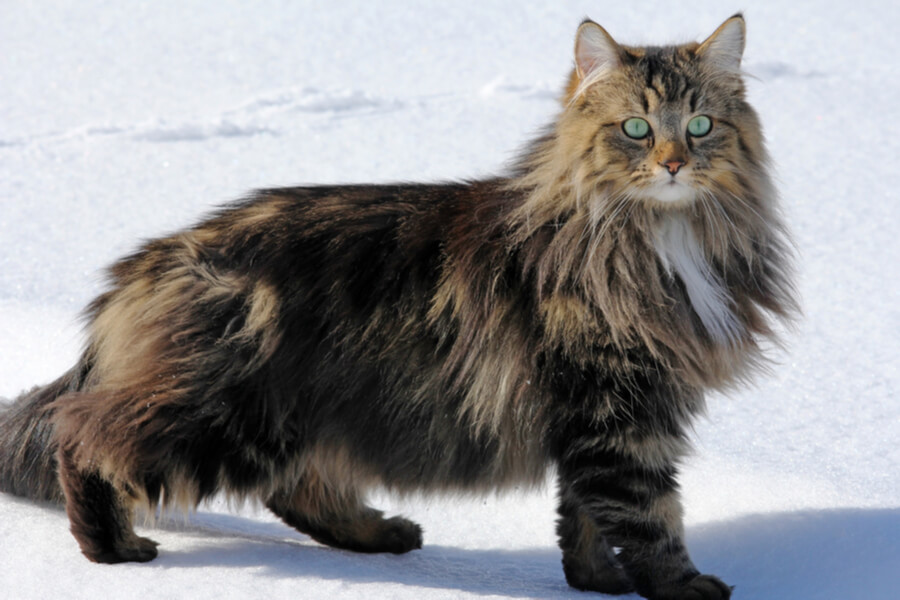
Norwegian Forest Cats are large to medium-large size boasting a solid build. They have a medium-long and rectangular body, and their back legs are higher than their forelegs. They are a well-muscled and heavily boned feline.
Their expressive and hypnotic eyes are big, wide, almond-shaped, and set on a slanted tilt. Their large ears are open and set in line with the triangular shape of their head. They may be well-tufted and have lynx tips. Their long tail is flowing and carried high.
The Norwegian Forest Cat is known for its thick, rich, water-repellent fur with a woolly undercoat covered by its long hairs. A fully coated cat has a full ruff and britches. Their coat feels thick, especially on tabbies. Solid, bicolour and tri-colour cats frequently have a softer coat.
The length of their coat is semi-long and should not be as long as a Persian coat. It comes in all colours with the exception of Chocolate, Lilac, Fawn, Siamese and Cinnamon (under the GCCF breed standard).
Norwegian Forest Cats are known to be gentle and friendly. They are fond of their family members but do not demand persistent petting and attention. They are simply pleased to be in the same room as their human companion and will entertain themselves if no one is home.
While they appreciate the company of their owners, they can be a bit reserved with guests. Even with family, they are not much of a lap cat. But a good scratch between their ears or under their chin is always welcome. With that, you will be rewarded with a nice head butt or cheek rub. Norwegian Forest cats communicate with typical Scandinavian restraint. Their quiet voice is used only when they need something.
Unexpectedly, this large and agile cat breed is a climber. Their long, muscular hind legs permit them to leap to high places with ease, so do not be surprised to discover them on top of furniture, doors, or other high places in your house. As a result, you will frequently find them at the highest point they can reach in a home.
Thanks to their heritage as a farm and wilderness cat, they don't have any fears about descending trees or other heigh. Moreover, because of their waterproof coat, the Wegie likes fishing in water for an enjoyable meal. They enjoy playing with cat toys and love catnip and chasing a laser light.
Wegies are very social, affectionate and get strongly devoted to members of their family. They love to play and thrive with a loving family that adores them. It is recommended that you provide your cat with a fitting scratching post. Norwegian Forest Cats prefer scratching posts wrapped in sisal rope. They also enjoy climbing, so a scratching post with seats is ideal.
These lively cats enjoy being involved in everything that happens in their environment. Being natural hunters, Norwegian Forest Cats love to discover and explore the great outdoors. Thus, they are an excellent choice for people who live in a country where it is safe for them to roam outside.
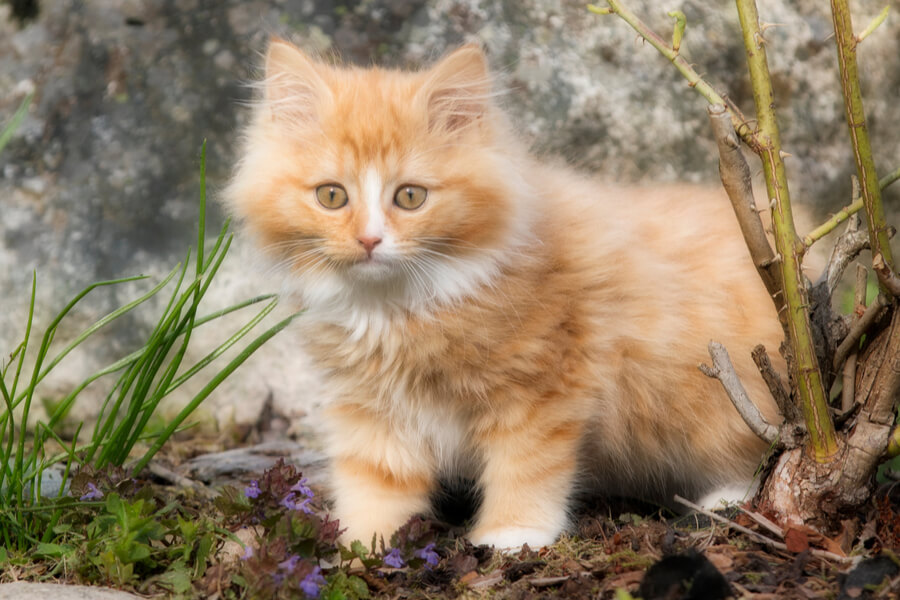
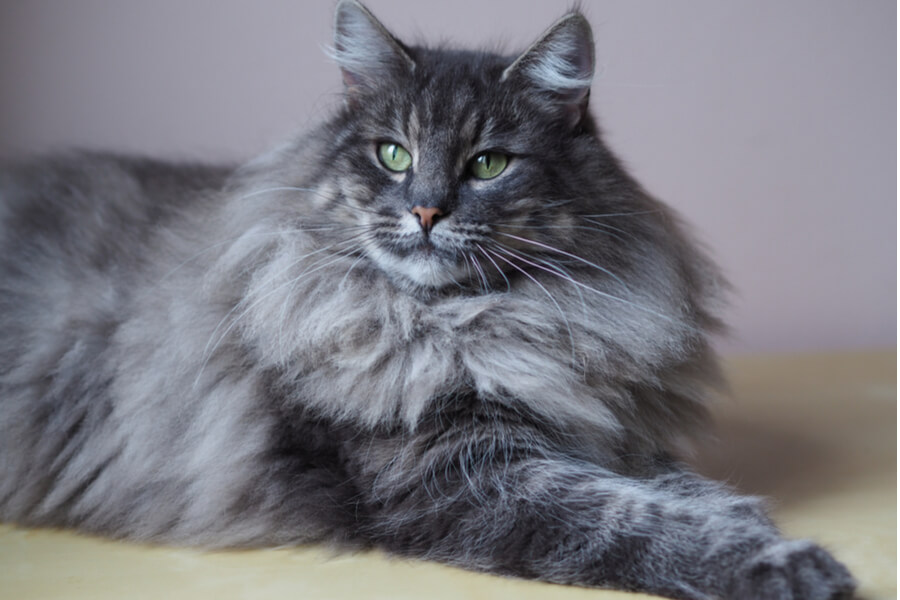
This cat breed is smart, independent and learns quickly. They enjoy the love and attention that comes with being clicker-trained. Challenge their brain and keep them interested by teaching them games and tricks. Provide them with puzzle toys and reward them with treats or kibbles when they learn how to manipulate them.
When a Norwegian Forest Cat is adequately socialised and trained during kittenhood, they will grow up to be a well-mannered and well-rounded cat.
Brush or comb your Norwegian Forest Cat's long coat at least twice a week. During times of heavy shedding (typically in the spring and fall), you may need to brush it every other day. You can use a bristle brush, stainless-steel comb or wire slicker brush. If you encounter any tangles, work them out softly so you do not hurt your cat.
A bath is hardly necessary unless they get particularly muddy and dirty. However, with your Norwegian Forest's virtually waterproof coat, it can be very tough to get them wet enough for a bath.
Cats must get used to combs and brushes from an early age to avoid matted fur. There's a wide variety of tools available on the market. You can start with a very soft brush that does not pull at your kitten’s fine fur or damage their skin. Each time you finish brushing, give a small treat. If regular coat care does not cause any issues or problems for you or your cat, try more effective combs and brushes when they reach adult age.
For dental hygiene, weekly tooth brushing is sufficient. Brushing their teeth helps to prevent periodontal disease so should not be omitted. You should also trim their nails twice a month or when needed, especially if they are indoor cats.
For their eyes, wipe the corners with a soft, damp cloth to eliminate any eye discharge. Make sure to use a separate part of the damp cloth for each eye to avoid spreading infection. Check the ears weekly. If they look dirty, wipe them out with a cotton ball or soft damp cloth moistened with a vet-approved ear cleaner. If the ear has a foul odour, it is best to contact your vet for treatment.
Their litter boxes should always be clean as they are precise about bathroom hygiene. If it is left unclean, they tend to use other places in the house.
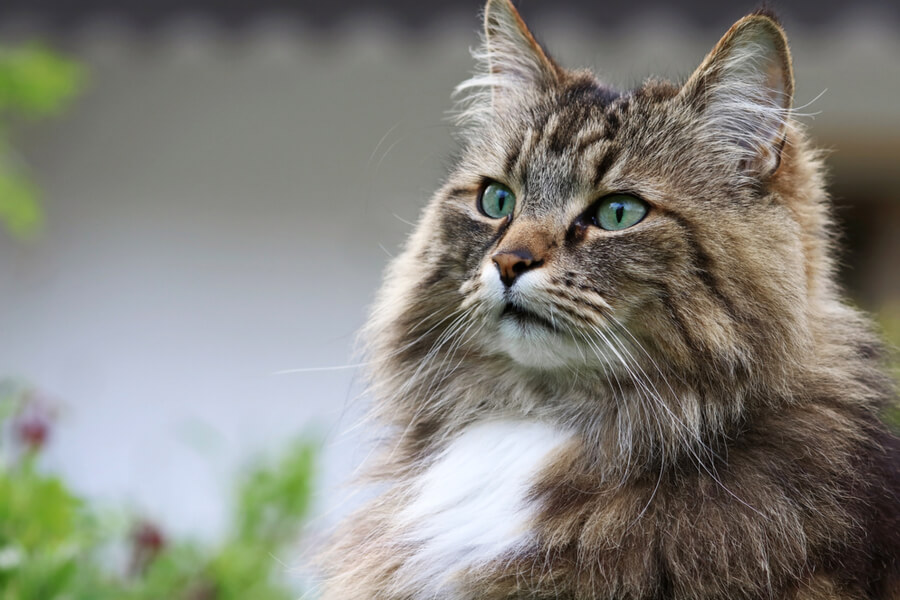
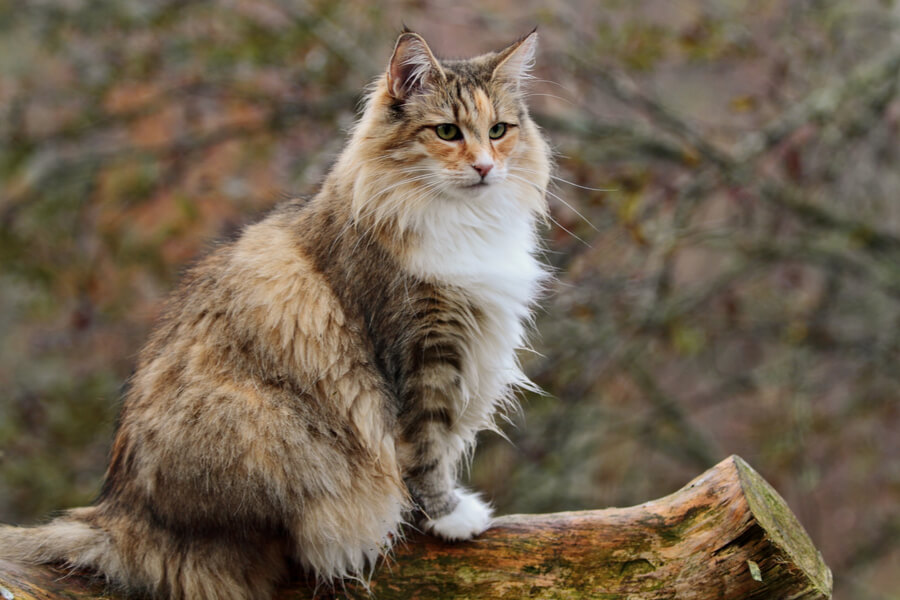
Norwegian Forest Cats are generally a healthy breed. Their life expectancy is between fourteen to sixteen years with proper care, exercise, and a high-quality diet. However, the following health conditions have been seen in this breed:
DNA tests can identify if a Norwegian Forest Cat carries genetic conditions like Glycogen Storage Disease IV. All ethical and responsible registered breeders will run these tests on their cats and provide you with the results. Thus, do not buy from any breeder who refuses to do so.
The welcoming, easy-going Norwegian Forest Cat is an ideal choice for families with children and cat-friendly dogs. They enjoy attention from children who treat them gently and respectfully. This gentle cat doesn’t even mind playing dress-up or riding in a baby buggy. Still, always supervise younger kids to avoid accidents like fur pulling or tail twisting
These cats are happy to live with other cats and cat-friendly dogs, too, thanks to their sociable character. However, it is still best to introduce pets gradually and in a controlled environment to guarantee that they learn to get along well together.
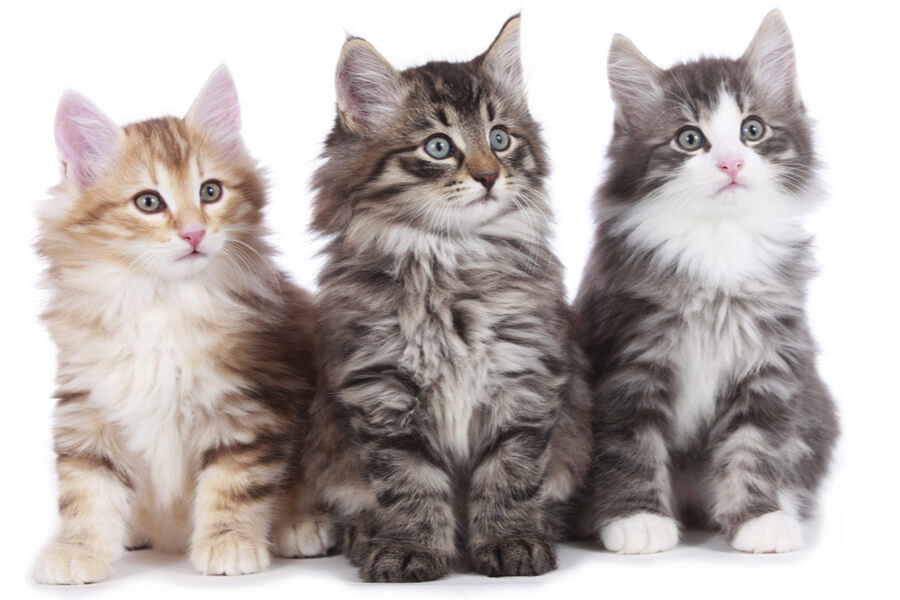

We can connect you with Breeders that are specialized in this particular breed.
See available kittens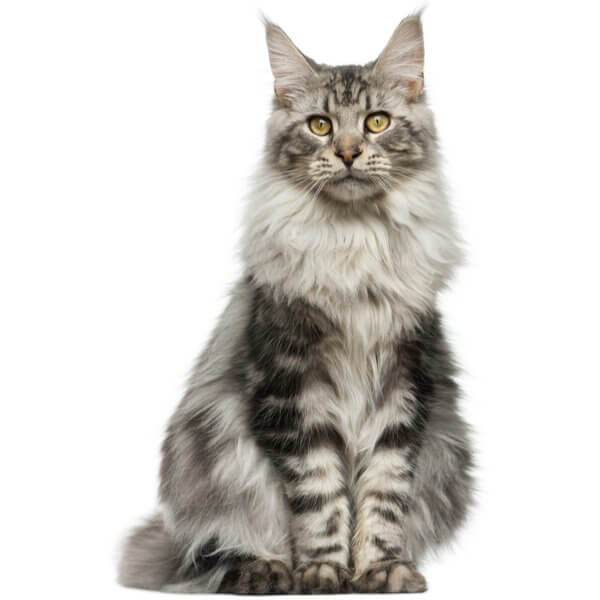
United States of America
Size : Large
Coat : Long
Registration : GCCF, TICA, CFA, FIFe
Vocality : Low
Hypoallergenic : No
Grooming : Twice a Week
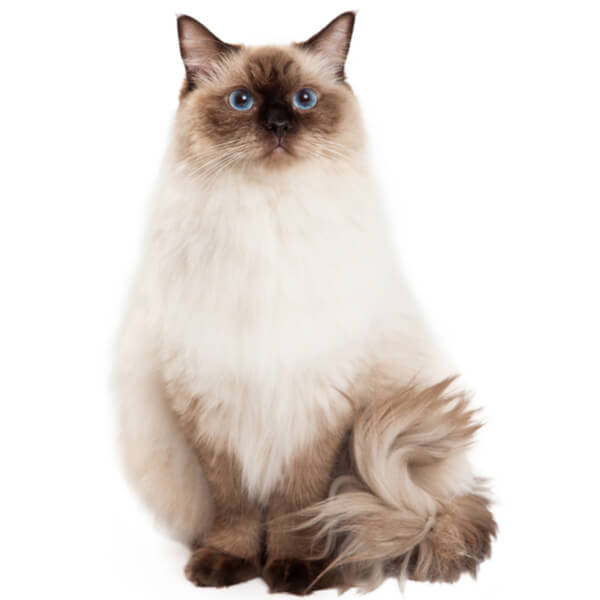
United States of America
Size : Large
Coat : Long
Registration : GCCF, TICA, CFA, FIFe
Vocality : Low
Hypoallergenic : No
Grooming : Twice a Week
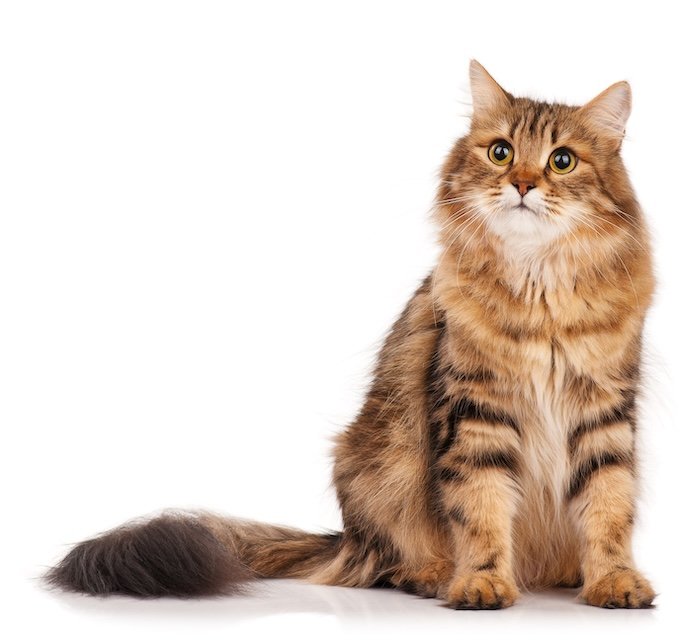
Russia
Size : Medium
Coat : Long
Registration : GCCF, TICA, CFA, FIFe
Vocality : Medium
Hypoallergenic : Yes
Grooming : Twice a Week
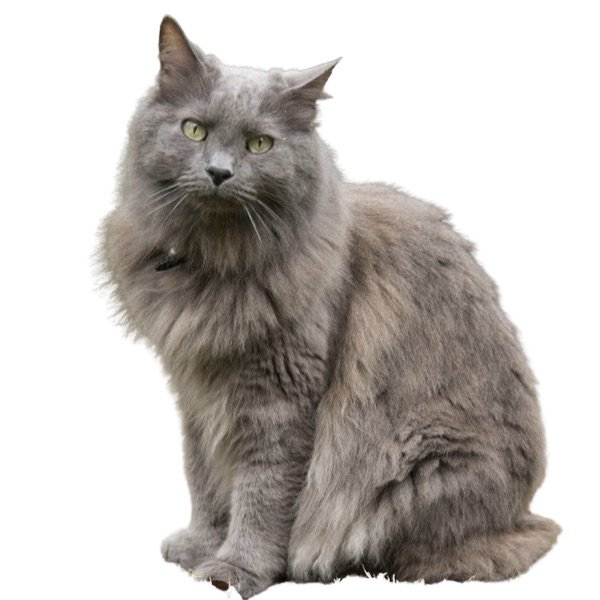
United States of America
Size : Medium
Coat : Long
Registration : GCCF, TICA
Vocality : Low
Hypoallergenic : No
Grooming : Twice a Week


Need some advice?
Whether you're a first time pet owner, an experienced pet owner, a new or long-time breeder, or just curious about pets, we've got you covered!

January 17, 2024
What Is The Personality Of Russian Blue Cats?
Russian Blue cats are most known for their distinctive shimmery blue-silver coat and piercing green eyes. However, this breed’s calm and gentle temperament is what makes them shine the most in the feline world.

January 17, 2024
10 Facts About Russian Blue Cat Breed
Russian Blues are one of the most aesthetically stunning cat breeds, with a gorgeous plush silvery coat and vibrant green eyes. However, it’s not only their appearance that is beautiful; their nature is too.

January 17, 2024
How To Choose The Right Cat Breed for You
Cats can make the most fantastic animal companions; they are adorable, friendly, and loving. However, not all felines are created equal. There are many different breeds, of which each has its unique personality traits.
Need some help?
Contact us to speak to our friendly advisor, who will gladly help you find your dream pet!



We are registered in England and Wales under registration number 12568840,
and our registered office is at 58-60 Kensington Church Street, W8 4DB London, England.
© 2023 The Pedigree Paws